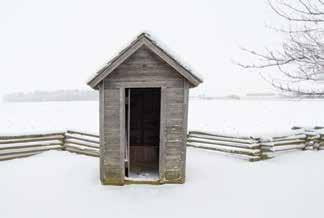
3 minute read
Field Notes
In the winter, when the wind is out of the north and blowing hard, when the fire in the wood furnace burns down overnight, there are mornings when the toilet seat in the bathroom of our bedroom is freezing. City girl that I am, I complained, and demanded a heated toilet seat, until my husband said, “We used an outhouse until 1969.”

Whenever my husband plays the growing-up-inrural-Nova-Scotia card, I shut up and listen because I’m fascinated by his stories of life before cell phones, indoor plumbing, and paved roads. Perhaps it’s an awareness that, like the veterans of World War Two who are our only link to the realities and brutalities of war, we are losing those who remember what life was like “back then”, before globalization, before the Internet, even before television.
My husband grew up in rural Cumberland County in the late ’50s, ’60s, and ’70s, in a farmhouse heated by a woodstove, which his mother cooked on year-round. They used an outhouse and got their water with a pump at the well.
“There was no insulation in the house and on winter mornings, I could write my name in the frost on the wall next to my bed,” Dwayne tells me.
He doesn’t remember it being that cold. “We were tough,” he grins. “It didn’t bother me.”
Growing up in Ontario, outhouses were merely characters in the stories my mother told about her childhood summers at family cottages. In fact, the only time I actually used an outhouse was when we visited Nova Scotia in the 1970s, and stayed at our friends’ camp on the backshore. They also pumped their water from a well next to the cabin. Just a hint of how my husband lived for the first thirteen years of his life.
The older I get and the longer I live in rural Nova Scotia, the more I appreciate “the way things were”. Every time the power goes out, instead of panicking and complaining, I now embrace the opportunity to experience how we used to live before urbanization drew many of us to towns and cities. In fact, storm-related power outages in rural Nova Scotia make having an outhouse as backup a pretty good idea.
After Hurricane Dorian, an older friend of mine decided she wanted a generator that will power the entire house so she won’t even notice that the electricity isn’t flowing through the wires. There’s something jarring about that, about our increasing reliance on machines rather than ourselves and our neighbours and our own resources.
While our pre-computer days weren’t always “the good old days”, there was a certain aspect of DIY, of taking care of ourselves with what we made with our hands, that was sensible and prudent. Just watch any advertisement for “virtual assistants” and you’ll understand how little we want to do things for ourselves these days. We don’t even want to look at a clock or flip a light switch!
“Alexa, turn on the heated toilet seat, please,” I might one day say as I’m lying in bed early in the morning.
Not likely.
A cold toilet seat first thing in the morning is a not-sogentle reminder that no matter how we try to control the world, the natural world of winter freeze and summer heat, of droughts and hurricanes, of clay soil and black soil, of high and low tides, will always exert the greatest influence over our lives.
Perhaps it’s the threat of catastrophic climate change that makes me feel like we might soon return to those “do it yourself” days of growing our own food, using candlelight after the sunset, maintaining a functioning outhouse, and we won’t have the ‘veterans’ of the 1940s, ’50s, and ’60s to show us how to survive.
There’s nothing nobler than the humble outhouse, and honestly, there’s nothing I long for more when the power goes out, cold toilet seat included.









